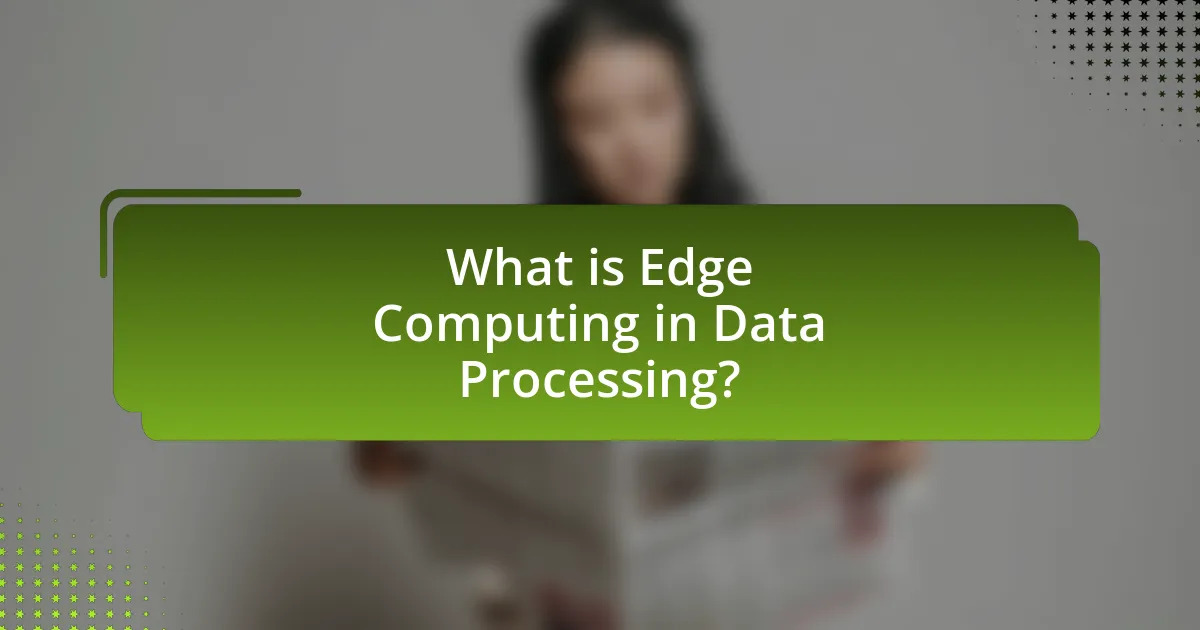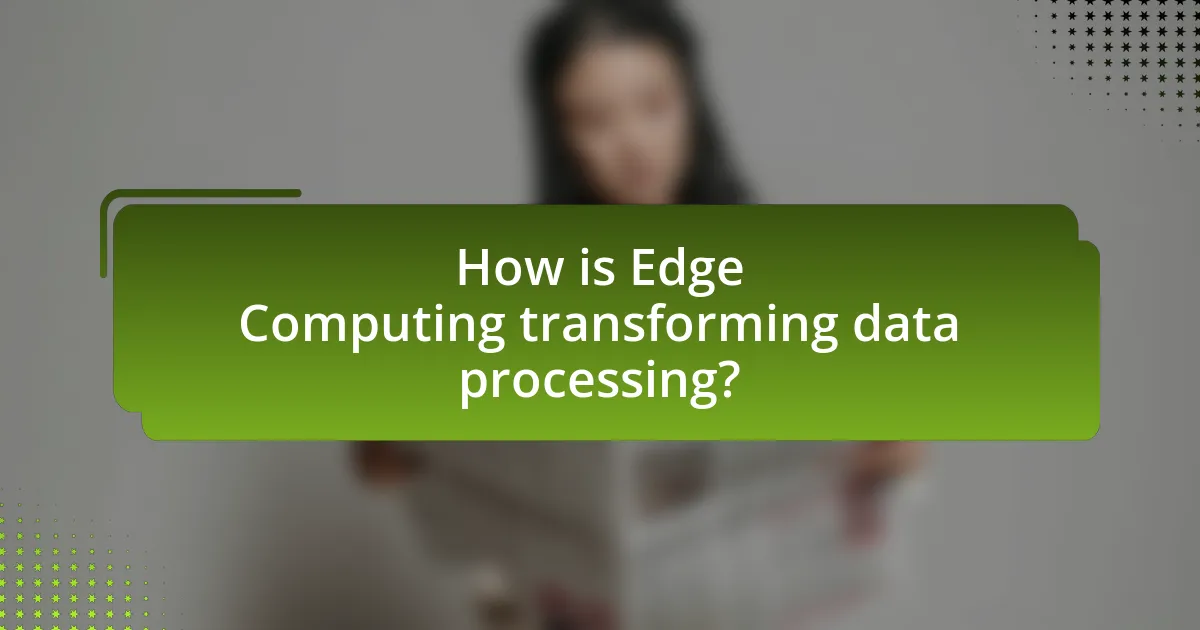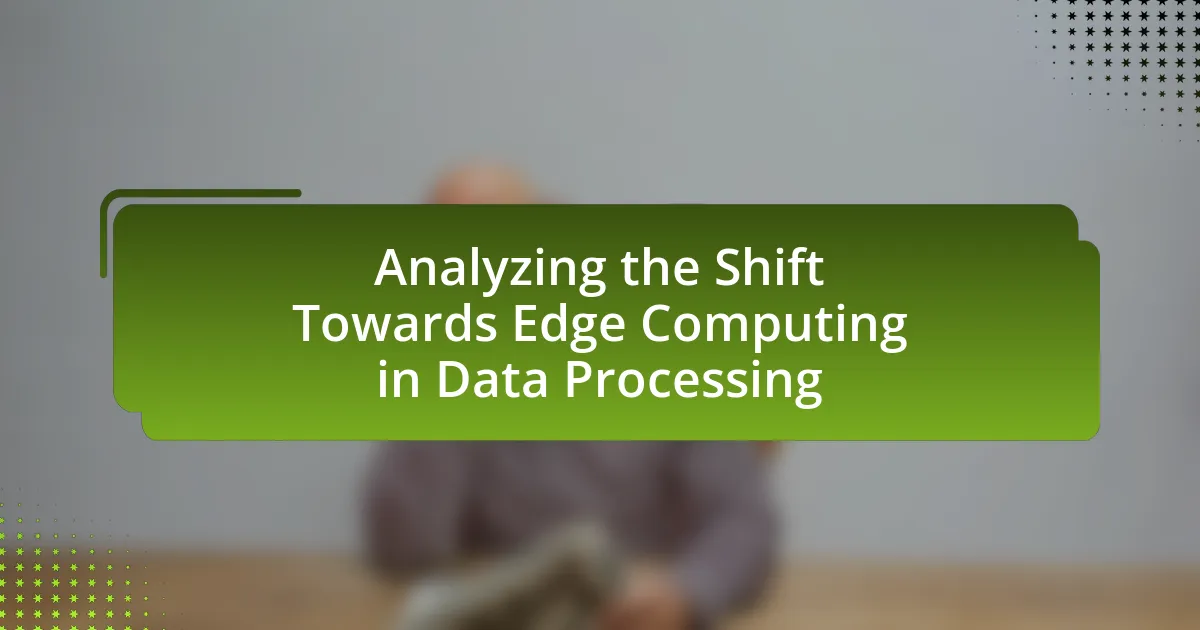Edge computing in data processing is a decentralized approach that processes data near its source, significantly reducing latency and improving bandwidth efficiency. This article explores the differences between edge computing and traditional cloud computing, highlighting its key characteristics, benefits, and the critical role of real-time data processing in various industries such as healthcare, manufacturing, and telecommunications. It also addresses the challenges of implementing edge computing, including security concerns and scalability issues, while discussing future trends driven by advancements in technology and the integration of 5G. The article emphasizes the importance of adopting best practices for a successful transition to edge computing, ensuring organizations can effectively leverage this transformative technology.

What is Edge Computing in Data Processing?
Edge computing in data processing refers to the practice of processing data near the source of data generation rather than relying solely on centralized data centers. This approach reduces latency, enhances speed, and improves bandwidth efficiency by minimizing the distance data must travel. For instance, in IoT applications, edge devices can analyze data locally, enabling real-time decision-making and reducing the load on cloud infrastructure. According to a report by Gartner, by 2025, 75% of enterprise-generated data will be processed outside centralized data centers, highlighting the growing importance of edge computing in modern data processing strategies.
How does Edge Computing differ from traditional cloud computing?
Edge computing processes data closer to the source of data generation, while traditional cloud computing relies on centralized data centers for processing. This proximity reduces latency, enabling faster data analysis and response times, which is critical for applications like IoT and real-time analytics. According to a report by Gartner, by 2025, 75% of enterprise-generated data will be created and processed outside centralized data centers, highlighting the growing importance of edge computing in modern data processing.
What are the key characteristics of Edge Computing?
Edge computing is characterized by its ability to process data closer to the source of generation, reducing latency and bandwidth use. This decentralized approach enables real-time data processing, which is crucial for applications like IoT and autonomous systems. Additionally, edge computing enhances security by minimizing data transmission to centralized servers, thereby reducing exposure to potential breaches. According to a report by Gartner, by 2025, 75% of enterprise-generated data will be created and processed outside a centralized data center, highlighting the growing importance of edge computing in modern data processing.
Why is latency a critical factor in Edge Computing?
Latency is a critical factor in Edge Computing because it directly impacts the speed and responsiveness of applications that rely on real-time data processing. In Edge Computing, data is processed closer to the source, reducing the distance that information must travel, which minimizes delays. For instance, applications in autonomous vehicles or industrial automation require instantaneous decision-making; even a few milliseconds of latency can lead to significant operational failures or safety risks. Research indicates that reducing latency can enhance user experience and system efficiency, making it essential for applications that demand high performance and reliability.
What are the primary drivers behind the shift to Edge Computing?
The primary drivers behind the shift to Edge Computing include the need for reduced latency, improved bandwidth efficiency, enhanced data security, and the growing demand for real-time data processing. Reduced latency is crucial for applications like autonomous vehicles and IoT devices, where immediate data processing is essential for functionality. Improved bandwidth efficiency arises from processing data closer to the source, minimizing the amount of data sent to centralized cloud servers, which is particularly important as the volume of data generated continues to rise. Enhanced data security is achieved by keeping sensitive information local, reducing exposure to potential breaches during data transmission. Lastly, the increasing demand for real-time data processing is driven by industries such as healthcare and manufacturing, where timely insights can significantly impact operations and decision-making. These factors collectively contribute to the accelerating adoption of Edge Computing technologies.
How do data privacy concerns influence the adoption of Edge Computing?
Data privacy concerns significantly influence the adoption of Edge Computing by driving organizations to process data closer to the source, thereby minimizing the risk of data breaches during transmission. As data privacy regulations like GDPR and CCPA become more stringent, companies are compelled to implement solutions that enhance data security and compliance. Edge Computing allows for localized data processing, which reduces the amount of sensitive information sent to centralized cloud servers, thus lowering exposure to potential cyber threats. According to a 2021 report by Gartner, 75% of enterprise-generated data will be created and processed outside centralized data centers by 2025, highlighting the shift towards Edge Computing as a response to privacy concerns.
What role does the Internet of Things (IoT) play in this shift?
The Internet of Things (IoT) significantly facilitates the shift towards edge computing in data processing by enabling real-time data collection and analysis at the source. IoT devices generate vast amounts of data that require immediate processing to enhance decision-making and operational efficiency. For instance, according to a report by Gartner, by 2025, over 75% of enterprise-generated data will be created and processed outside centralized data centers, highlighting the critical role of IoT in driving this transition. This decentralized approach reduces latency, minimizes bandwidth usage, and improves response times, making edge computing a vital component in managing the data produced by IoT devices.
What challenges are associated with implementing Edge Computing?
Implementing Edge Computing presents several challenges, including security concerns, interoperability issues, and resource management complexities. Security is a significant challenge due to the distributed nature of edge devices, which can be more vulnerable to attacks compared to centralized systems. Interoperability issues arise as various devices and platforms may not communicate effectively, complicating integration. Additionally, managing resources such as bandwidth, storage, and processing power at the edge can be complex, especially in environments with numerous devices generating large volumes of data. These challenges highlight the need for robust strategies and technologies to ensure successful Edge Computing deployment.
How can organizations address security issues in Edge Computing?
Organizations can address security issues in Edge Computing by implementing robust encryption protocols and establishing strict access controls. Encryption protects data both in transit and at rest, ensuring that sensitive information remains secure from unauthorized access. For instance, using AES (Advanced Encryption Standard) can significantly enhance data security. Additionally, organizations should adopt multi-factor authentication (MFA) to strengthen access controls, reducing the risk of unauthorized entry into edge devices. According to a report by Gartner, by 2025, 75% of enterprise-generated data will be created and processed outside a centralized data center, highlighting the need for enhanced security measures at the edge. Regular security audits and updates to software and firmware also play a crucial role in mitigating vulnerabilities, ensuring that edge devices are protected against emerging threats.
What are the scalability concerns related to Edge Computing?
Scalability concerns related to Edge Computing include limited resources at edge nodes, network latency, and the complexity of managing distributed systems. Edge nodes often have constrained processing power and storage compared to centralized cloud data centers, which can hinder the ability to scale applications effectively. Additionally, as the number of edge devices increases, maintaining low latency becomes challenging due to potential bottlenecks in data transmission. The complexity of orchestrating and managing numerous distributed nodes also complicates scalability, as it requires sophisticated management tools and strategies to ensure seamless operation across diverse environments. These factors collectively impact the ability to scale edge computing solutions efficiently.

How is Edge Computing transforming data processing?
Edge computing is transforming data processing by enabling data to be processed closer to its source, thereby reducing latency and bandwidth usage. This shift allows for real-time data analysis and decision-making, which is crucial for applications such as IoT devices, autonomous vehicles, and smart cities. According to a report by Gartner, by 2025, 75% of enterprise-generated data will be created and processed outside a centralized data center, highlighting the significant impact of edge computing on data processing paradigms.
What are the benefits of using Edge Computing for data processing?
Edge computing offers significant benefits for data processing, primarily by reducing latency and improving response times. By processing data closer to the source, edge computing minimizes the distance data must travel, which enhances real-time analytics and decision-making. Additionally, it alleviates bandwidth constraints by filtering and processing data locally, sending only relevant information to centralized cloud servers. This localized processing can lead to increased reliability and security, as sensitive data can be managed on-site rather than transmitted over potentially vulnerable networks. According to a report by Gartner, by 2025, 75% of enterprise-generated data will be created and processed outside centralized data centers, highlighting the growing importance and effectiveness of edge computing in modern data processing strategies.
How does Edge Computing enhance real-time data analysis?
Edge Computing enhances real-time data analysis by processing data closer to the source, which reduces latency and bandwidth usage. This proximity allows for quicker data insights and decision-making, as data does not need to travel to a centralized cloud server for analysis. For instance, in industrial IoT applications, edge devices can analyze sensor data instantly, enabling immediate responses to anomalies. According to a study by Gartner, by 2025, 75% of enterprise-generated data will be created and processed outside centralized data centers, highlighting the growing importance of edge computing in facilitating timely data analysis.
What cost savings can organizations expect from Edge Computing?
Organizations can expect significant cost savings from Edge Computing, primarily through reduced bandwidth costs and lower latency. By processing data closer to the source, Edge Computing minimizes the need to transmit large volumes of data to centralized cloud servers, which can lead to substantial savings on data transfer fees. For instance, a study by Gartner indicates that organizations can save up to 30% on bandwidth costs by implementing Edge Computing solutions. Additionally, the reduction in latency enhances operational efficiency, which can lead to decreased operational costs and improved productivity. This efficiency is particularly beneficial for industries requiring real-time data processing, such as manufacturing and healthcare, where delays can result in costly downtime or inefficiencies.
Which industries are leading the adoption of Edge Computing?
The industries leading the adoption of Edge Computing include telecommunications, manufacturing, healthcare, and transportation. Telecommunications companies utilize edge computing to enhance network performance and reduce latency for services like 5G. In manufacturing, edge computing enables real-time data processing for IoT devices, improving operational efficiency. Healthcare organizations leverage edge computing for real-time patient monitoring and data analysis, enhancing patient care. Transportation companies implement edge computing to optimize logistics and improve safety through real-time data processing. These industries are at the forefront due to their need for low-latency processing and real-time data analytics.
How is Edge Computing impacting the healthcare sector?
Edge computing is significantly enhancing the healthcare sector by enabling real-time data processing at the source of data generation. This technology reduces latency, allowing healthcare providers to access and analyze patient data instantly, which is crucial for timely decision-making in critical care situations. For instance, edge computing facilitates the use of wearable health devices that continuously monitor vital signs and send alerts to medical professionals without the delays associated with cloud computing. According to a report by the International Data Corporation, the healthcare industry is projected to invest over $34 billion in edge computing by 2025, highlighting its growing importance in improving patient outcomes and operational efficiency.
What applications of Edge Computing are emerging in manufacturing?
Emerging applications of Edge Computing in manufacturing include real-time monitoring, predictive maintenance, and quality control. Real-time monitoring allows manufacturers to track equipment performance and production processes instantly, enhancing operational efficiency. Predictive maintenance leverages data analytics at the edge to anticipate equipment failures before they occur, reducing downtime and maintenance costs. Quality control applications utilize edge devices to analyze product quality in real-time, ensuring adherence to standards and minimizing waste. These applications are supported by the increasing deployment of IoT devices and sensors in manufacturing environments, which generate vast amounts of data that can be processed locally for immediate insights.

What are the future trends in Edge Computing for data processing?
Future trends in Edge Computing for data processing include increased adoption of artificial intelligence at the edge, enhanced security measures, and the integration of 5G technology. The deployment of AI algorithms directly on edge devices allows for real-time data analysis, reducing latency and bandwidth usage. Enhanced security measures are becoming critical as more devices connect to the edge, with a focus on data encryption and secure access protocols to protect sensitive information. The integration of 5G technology facilitates faster data transmission and supports a higher density of connected devices, enabling more robust edge computing applications. According to a report by Gartner, by 2025, 75% of enterprise-generated data will be created and processed outside a centralized data center, highlighting the shift towards edge computing.
How will advancements in technology shape Edge Computing?
Advancements in technology will significantly enhance Edge Computing by improving processing speed, reducing latency, and enabling real-time data analytics. For instance, the integration of 5G networks facilitates faster data transmission, allowing edge devices to process information closer to the source, which minimizes delays. Additionally, advancements in artificial intelligence and machine learning algorithms enable more efficient data processing at the edge, allowing for smarter decision-making without relying heavily on centralized cloud resources. According to a report by Gartner, by 2025, 75% of enterprise-generated data will be created and processed outside a centralized data center, underscoring the transformative impact of these technological advancements on Edge Computing.
What role will artificial intelligence play in Edge Computing?
Artificial intelligence will enhance Edge Computing by enabling real-time data processing and decision-making at the network’s edge. This capability allows for reduced latency and improved efficiency, as AI algorithms can analyze data locally rather than relying on centralized cloud resources. For instance, AI-driven analytics can optimize bandwidth usage and resource allocation, which is crucial in environments with limited connectivity. According to a report by Gartner, by 2025, 75% of enterprise-generated data will be created and processed outside a centralized data center, highlighting the growing importance of AI in managing and interpreting data at the edge.
How might 5G technology accelerate the growth of Edge Computing?
5G technology accelerates the growth of Edge Computing by providing significantly higher data transfer speeds, lower latency, and increased connectivity for devices. The enhanced bandwidth of 5G allows for real-time data processing at the edge, enabling applications such as autonomous vehicles and smart cities to function effectively. For instance, 5G can achieve speeds up to 10 Gbps, which is up to 100 times faster than 4G, facilitating quicker data analysis and decision-making at the edge. Additionally, the reduced latency of 1 millisecond or less in 5G networks supports time-sensitive applications, making Edge Computing more viable for industries requiring immediate data processing. This synergy between 5G and Edge Computing is crucial for the proliferation of IoT devices, which are expected to reach over 75 billion by 2025, further driving the demand for localized data processing solutions.
What best practices should organizations follow when adopting Edge Computing?
Organizations should follow several best practices when adopting Edge Computing to ensure effective implementation and operation. First, they should assess their specific use cases and requirements to determine the appropriate edge architecture, as this aligns technology with business needs. Second, organizations must prioritize security by implementing robust encryption and access controls, given that edge devices can be more vulnerable to attacks. Third, they should ensure seamless integration with existing IT infrastructure to facilitate data flow and management, which is crucial for operational efficiency. Fourth, organizations need to invest in training and skill development for their workforce to effectively manage and utilize edge technologies. Lastly, continuous monitoring and optimization of edge deployments are essential to adapt to changing demands and improve performance. These practices are supported by industry reports indicating that organizations that prioritize these areas experience higher success rates in their edge computing initiatives.
How can businesses ensure a smooth transition to Edge Computing?
Businesses can ensure a smooth transition to Edge Computing by implementing a phased approach that includes assessing current infrastructure, investing in training, and establishing clear data governance policies. Assessing current infrastructure allows businesses to identify gaps and determine necessary upgrades, ensuring compatibility with edge technologies. Investing in training equips employees with the skills needed to manage and operate edge devices effectively, which is crucial as 70% of organizations report a skills gap in their workforce regarding new technologies. Establishing clear data governance policies ensures compliance and security, as edge computing often involves processing sensitive data closer to the source. These steps collectively facilitate a structured transition, minimizing disruptions and enhancing operational efficiency.
What strategies can enhance the security of Edge Computing implementations?
Implementing strong encryption protocols is a key strategy to enhance the security of Edge Computing implementations. Encryption protects data both in transit and at rest, ensuring that sensitive information remains confidential even if intercepted. For instance, using AES (Advanced Encryption Standard) with a 256-bit key can significantly reduce the risk of unauthorized access. Additionally, regular software updates and patch management are crucial, as they address vulnerabilities that could be exploited by attackers. According to a report by the Cybersecurity & Infrastructure Security Agency (CISA), timely updates can mitigate 85% of known vulnerabilities. Furthermore, employing multi-factor authentication (MFA) adds an extra layer of security, making it more difficult for unauthorized users to gain access to edge devices. Implementing these strategies collectively strengthens the overall security posture of Edge Computing environments.



